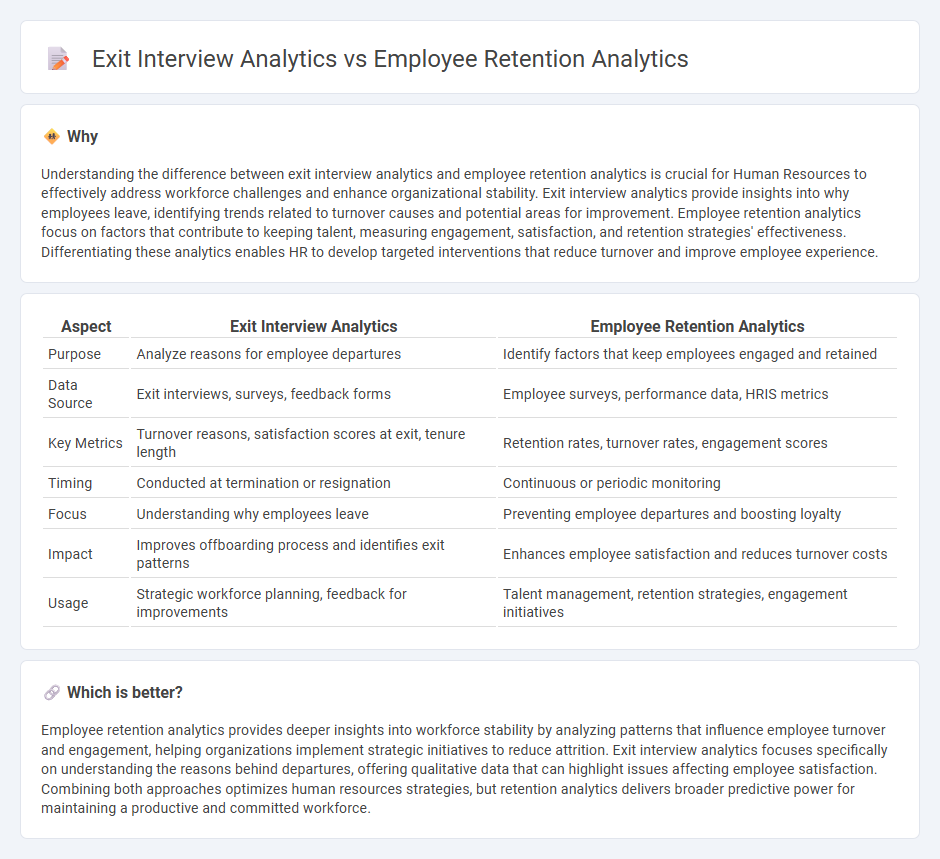
Exit interview analytics focus on understanding why employees leave by analyzing feedback from departure interviews, identifying patterns in turnover causes. Employee retention analytics examine factors that influence employees to stay, such as job satisfaction, engagement levels, and workplace culture. Explore how combining these insights can improve overall talent management strategies.
Why it is important
Understanding the difference between exit interview analytics and employee retention analytics is crucial for Human Resources to effectively address workforce challenges and enhance organizational stability. Exit interview analytics provide insights into why employees leave, identifying trends related to turnover causes and potential areas for improvement. Employee retention analytics focus on factors that contribute to keeping talent, measuring engagement, satisfaction, and retention strategies' effectiveness. Differentiating these analytics enables HR to develop targeted interventions that reduce turnover and improve employee experience.
Comparison Table
| Aspect | Exit Interview Analytics | Employee Retention Analytics |
|---|---|---|
| Purpose | Analyze reasons for employee departures | Identify factors that keep employees engaged and retained |
| Data Source | Exit interviews, surveys, feedback forms | Employee surveys, performance data, HRIS metrics |
| Key Metrics | Turnover reasons, satisfaction scores at exit, tenure length | Retention rates, turnover rates, engagement scores |
| Timing | Conducted at termination or resignation | Continuous or periodic monitoring |
| Focus | Understanding why employees leave | Preventing employee departures and boosting loyalty |
| Impact | Improves offboarding process and identifies exit patterns | Enhances employee satisfaction and reduces turnover costs |
| Usage | Strategic workforce planning, feedback for improvements | Talent management, retention strategies, engagement initiatives |
Which is better?
Employee retention analytics provides deeper insights into workforce stability by analyzing patterns that influence employee turnover and engagement, helping organizations implement strategic initiatives to reduce attrition. Exit interview analytics focuses specifically on understanding the reasons behind departures, offering qualitative data that can highlight issues affecting employee satisfaction. Combining both approaches optimizes human resources strategies, but retention analytics delivers broader predictive power for maintaining a productive and committed workforce.
Connection
Exit interview analytics reveal patterns in employee departures, providing valuable data on reasons for turnover and workplace dissatisfaction. Employee retention analytics use this data to identify risk factors and implement targeted strategies that improve job satisfaction and reduce attrition rates. Together, these analytics create a feedback loop that enhances workforce stability and optimizes human resource management.
Key Terms
**Employee Retention Analytics**
Employee Retention Analytics leverages data from various sources like performance metrics, employee engagement surveys, and turnover rates to identify patterns and predictors of employee departure, enabling proactive retention strategies. Advanced tools use machine learning algorithms to analyze factors such as compensation trends, career development opportunities, and workplace culture satisfaction to improve retention rates effectively. Discover how integrating Employee Retention Analytics can transform your workforce management and reduce costly turnover.
Turnover Rate
Employee retention analytics focuses on identifying patterns and factors influencing employee turnover rate by analyzing workforce data such as tenure, performance, and engagement scores. Exit interview analytics examines qualitative and quantitative feedback from departing employees to uncover reasons behind voluntary turnover and areas for organizational improvement. Explore how combining both approaches provides comprehensive insights to reduce turnover rate and boost retention strategies.
Predictive Modeling
Employee retention analytics utilizes predictive modeling to identify patterns and factors that influence employee turnover, enabling proactive strategies to enhance workforce stability. Exit interview analytics focuses on analyzing qualitative data from departing employees to uncover reasons behind attrition but lacks the forward-looking capability of predictive models. Explore how integrating predictive analytics with exit interview insights can optimize retention strategies and reduce turnover costs.
Source and External Links
HR Analytics: Everything You Need to Know - Employee retention analytics uses data from exit interviews, turnover rates, and satisfaction scores to identify causes of attrition and predict flight risks, enabling targeted strategies to improve retention and reduce turnover costs.
The Power of Employee Retention Analytics - Predictive analytics apply machine learning to historical employee data to detect turnover patterns and flag at-risk employees early, allowing HR to intervene with focused retention efforts before departures occur.
How HR Leaders Use People Analytics to Retain Employees - HR leaders use comprehensive people analytics covering the entire employee lifecycle to find patterns influencing turnover and implement tailored interventions like adjusted pay or mentoring programs to boost retention.
 dowidth.com
dowidth.com